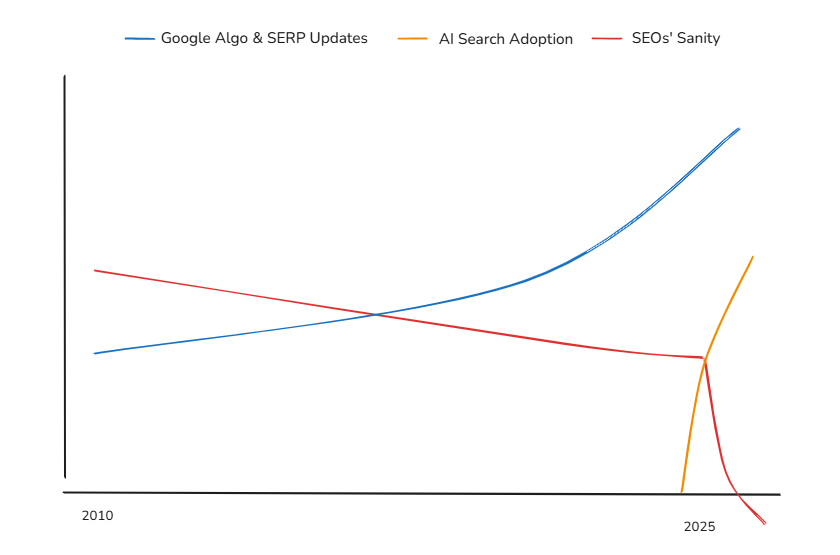
Back to Basics: 3 SEO Pillars That Will Future-Proof Your Organic Growth
Published October 21, 2025
Thank you to Paula Gonzalez who calmly brings us back to the 3 SEO pillars that will stand your strategy in good stead, even in this crazy world of AI search.
In a world filled with noise, AI slop and contradicting SEO advice – where do we focus for impact?
In this article I’ll cut through the chaos (and the “SEO is dead” rhetoric) to help ground your strategy in three core pillars that will withstand the AI storm.
Contents:
Current State of Search
Organic clicks and CTR has been steadily declining for over a decade, ever since Google introduced Featured Snippets in 2014.

Source: Advanced Web Ranking, Organic CTR over time.
By March 2025, 27.2% of US searches ended with no clicks at all. Meaning, users found their answers directly on the SERP (Search Engine Land, 2025).
By October 2025, SERPs featuring AI Overviews had grown +146% year-on-year, with 57% of US search queries eligible to show an AI Overview (Advanced Web Ranking, 2025).
Meanwhile, the lines within SEO & Brand have blurred. AI is condensing the customer journey from discovery to conversion, echoing every customer complaint ever left on the internet...and your boss is asking you why we can’t “rank” in ChatGPT or Gemini.

And yet, amid all this whirlwind, the foundations to Organic Growth actually remain the same.
What are those 3 pillars and why they’re still valid
The 3 pillars we have been referring to are: Technical (Accessibility), Content (Resonance) and Brand (Perception).
Pillar #1: Technical (Accessibility)
It’s well established by now that technical accessibility is fundamental. If you are reading this, chances are that you are already using Sitebulb to audit your site – good start.
If Google can’t access and crawl your pages, it won’t be able to read your content, rank it for keywords, drive traffic nor conversions. Simple.
And the same logic applies to AI tools.
So make sure, when it comes to tech SEO, you’ve covered the basics:
Technical SEO best practices
Audit your CDN setup and geographical restrictions: Geo-blocking or aggressive rate limiting can prevent crawlers from accessing the site, leading to incomplete indexing.
Ask your (insert adjective) developers to give you access to Log Files: Server logs are ground truth. They show exactly which bot, how often and what pages are being requested, demystifying assumptions on crawl budget.
Ensure your content and links are fully crawlable without JavaScript: While Google can render JavaScript, it requires more resources and it is often delayed. This is especially key for AI tools like ChatGPT or Perplexity which don’t render JavaScript.
💡 Tip: Test with Sitebulb’s Response vs Render Report to see what’s visible to bots.Review your robots.txt and ensure you aren’t blocking valuable resources or pages: Blocking CSS, JS or images can prevent Google from actually seeing the page partially or completely. Blocking essential pages like pagination prevents product indexation.
Make sure Google isn’t encountering errors when fetching JS resources: Use Google Search Console inspection URL to make sure Google can see all the main content and links and spot any issues rendering JS resources.
Review your canonical and noindex setup: Mismanaged canonical tags lead to duplicated content (confusing and crawl budget waste for search engines). Incorrect use of the “noindex” can de-index essential pages, harming visibility.
Confirm your core business pages (categories, products etc) receive enough internal link equity: Internal linking is how you signal Google and AI what pages are important to your site. Higher click depth makes pages look less important to crawlers.
Check HTTPs and ensure all resources are served securely (avoid mix content): Mix content breaks security and can degrade performance.
Review Hreflang tags: If serving the same content in different languages or regions, ensure your hreflang tag setup is adequate to prevent duplication issues.
And to the list above – and generally speaking, with lesser priority – add monitoring Core Web Vitals and schema markup validation.
Note: While I’ve yet to see a clear, direct correlation between Core Web Vitals or schema markup and rankings, CWV are a known ranking factor. But most importantly, they are key to your users’ experience and have shown to improve conversion rates.
Schema Markup, on the other hand, assists search engines and AI tools in gaining a greater understanding of your site.
Pillar #2: Content that resonates
Long gone are the days where users would happily consume your keyword-stuffed, written-for-search-engines content.
In a world where AI can replicate every article written, synthesise it, strip it down to the bare bones and rebuild it – while hallucinating along the way – users want something else.
Users are, well…human beings. And like every human, we crave connection and resonance.
If you want your content to outlive AI – and serve a greater purpose for your brand – don’t start with keyword research (because every SEO will start there too).
Start by understanding your customers first.
Start by understanding:
What content are they missing?
What topics do they speak about the most?
Are we serving them the same recycled information as everyone else?
Are we speaking their language?
Do we talk to their pain-points, frustrations and desires?
Ideally, you’d use a Voice of the Customer (VoC) framework to guide this process. But if your brand doesn’t have one yet, you can begin by exploring Reddit’s API (free to use) – head here for a step by step guide and script so you can start today.
You can look at your long-tail branded searches in GSC, customer reviews and user generated content on social media to understand what people are really talking about and how they are talking about it.
All of this will help you uncover trends, language, frustrations and competitor gaps your brand could leverage.
Then – and only then – I recommend doing keyword research and optimising your content on-site for search engines.
Pillar #3: Brand Perception (the new authority)
It started with backlinks, soon came PR and mentions.
Now, we’re in the era of brand perception as the new brand authority.
Before, negative reviews, comments or opinions were confined to their own platform. Meaning – if you didn’t search and click on that Reddit thread, Trustpilot page, Quora post or Google Review – chances are you’d never have seen what fellow peers thought about that brand or product you were considering.
But that also meant that shady companies could still rank and get away with it.
A direct link between Brand & Organic Visibility was, at best, an unconfirmed but openly suspected truth.
Now, however, AI is amplifying and echoing every brand signal on the internet back at users:
“This brand has a 3.2/5 on Trustpilot”.
“Users don’t recommend this product due to…”.
“The brand faced backlash after…”
Therefore, in the era of AI, brand authority isn’t just more important than ever – it’s also more visible, quoted and unfiltered.
We’ll never be certain what sentiment ChatGPT or Gemini are using when describing our brand and services. But we can monitor and therefore, act.
How to assess brand perception
Here is how I break it down:
Entities → Is your brand consistent across Google’s Knowledge Graph, Wikidata, Crunchbase etc.?
Trust → Does your brand promise match your customer’s lived experience? (reviews, forums etc).
Authority → Are you earning mentions from credible, high-authority media or industry sources?
Demand → Is branded search demand growing or declining over time?
Reputation → What’s the overall sentiment? Any legacy negative narratives that need addressing?
Expertise → Are you visibly showcasing thought leadership and credibility in your content?
Experience → Are users engaging, clicking, converting and returning?
Engagement → Are users talking about you? Does your brand generate organic UGC, reviews, comments, shares?
In short: every one of the layers above represents a brand signal on how your brand is perceived by users and the internet. These have a direct impact on AI visibility, sentiment and overall SEO performance.
Key Take Aways
The old division lines between discovery and conversion, performance and branding are blurring. New customer acquisition is getting harder and customers are bombarded with noise.
But AI hasn’t changed what matters for your users, your business or your organic growth – it has only made everything more connected and amplified.
Technical accessibility will make your products and services discoverable, as it always has.
Content resonance makes your brand relevant and loved, helping your message cut through the AI slop.
Brand perception will make you trusted and visible, fueling retention and referral loops.
Focusing on these three basics means future-proofing your Organic Strategy.

Sitebulb is a proud partner of Women in Tech SEO! This author is part of the WTS community. Discover all our Women in Tech SEO articles.

Paula Gonzalez is a Customer-led Growth Strategist. With over 10 years of experience in Growth Marketing - much of it focused on organic channels - she combines coding skills and market research expertise to turn customer insights into actionable growth systems, bridging the gap between SEO, content, brand and customer experience teams.
Articles for every stage in your SEO journey. Jump on board.
Related Articles
 Speed-to-Meaning: Technical & Measurement Blueprint for AI Search
Speed-to-Meaning: Technical & Measurement Blueprint for AI Search
 How to Stay Relevant in a World of AI Overviews & Query-Fans
How to Stay Relevant in a World of AI Overviews & Query-Fans
 Plain-text Lifelines: How to Make Medical Content Visible in AI Search
Plain-text Lifelines: How to Make Medical Content Visible in AI Search
 Sitebulb Desktop
Sitebulb Desktop
Find, fix and communicate technical issues with easy visuals, in-depth insights, & prioritized recommendations across 300+ SEO issues.
- Ideal for SEO professionals, consultants & marketing agencies.
Try our fully featured 14 day trial. No credit card required.
Try Sitebulb for free Sitebulb Cloud
Sitebulb Cloud
Get all the capability of Sitebulb Desktop, accessible via your web browser. Crawl at scale without project, crawl credit, or machine limits.
- Perfect for collaboration, remote teams & extreme scale.
If you’re using another cloud crawler, you will definitely save money with Sitebulb.
Explore Sitebulb Cloud
 Paula Gonzalez
Paula Gonzalez

